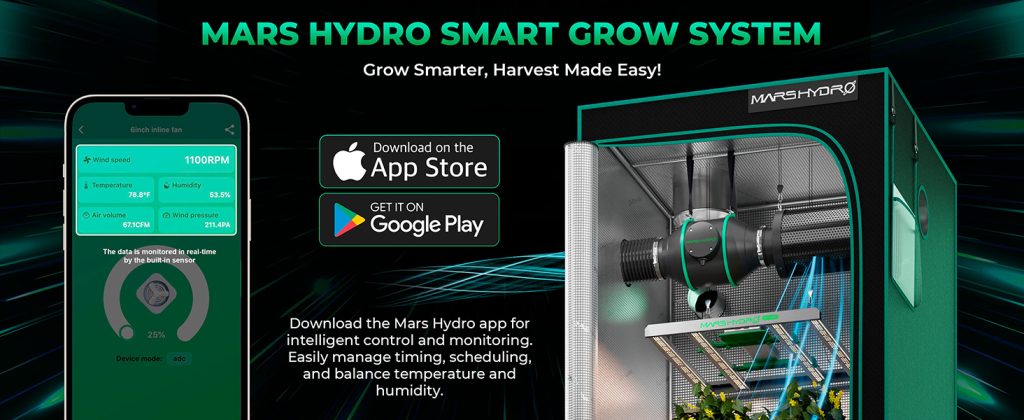Air is essential for the survival and energy production of green plants, which absorb carbon dioxide and emit oxygen during photosynthesis. Natural winds also help plants grow strong fibers to resist gusty conditions. Although outdoor plants adapt to the changing air dynamics of winter, indoor plants lack natural airflow and the strengthening effect of wind. Thus, it's crucial for indoor gardeners to optimize air circulation and ventilation in grow tents to closely replicate outdoor conditions.
This guide explores the critical components of a grow room ventilation system, highlighting its importance and detailing the necessary setup to achieve optimal air circulation, ensuring that even in the controlled environment of a grow room, plants can thrive as if they were in the great outdoors.
Why Is Optimal Grow Tent Circulation and Ventilation Essential?
As previously mentioned, the health of your indoor plants is highly dependent on air quality. Here are key reasons why optimal air circulation and ventilation in your grow room are essential:
1. Carbon Dioxide Replenishment: Effective circulation systems ensure a constant influx of fresh, cool air high in carbon dioxide, while expelling used oxygen, maintaining perfect CO2 levels for photosynthesis.
2. Temperature and Humidity Control: Without the natural wind and sunlight that outdoor plants benefit from, grow rooms can have stagnant air. Proper ventilation helps remove excess heat and moisture, ensuring optimal temperatures and hydration for your plants.
3. Stem Strengthening: A strong ventilation system can simulate the natural wind, enhancing the strength of plant stems. This supports healthy, upright growth, enabling plants to bear more fruits or seeds.
4. Pest and Disease Prevention: Pests and diseases thrive in stagnant or humid conditions. A dry, airy environment, created by effective ventilation, is crucial for protecting your plants from issues like fungus gnats, spider mites, powdery mildew, and mold.
What Do You Need To Set Up A Ventilation System For Your Grow Room in Winter?
A grow room ventilation system includes several crucial components that work together to optimize the growing environment for plants. Here’s an overview of some key elements:
1. Oscillating Fans: These fans are pivotal in circulating air throughout the grow room, ensuring that air reaches every corner. They are straightforward to install and are effective in enhancing air movement.
2. Inline Duct Fans: These fans, also known as exhaust fans, remove hot and humid air from the grow area, helping to control the internal climate. They can also introduce fresh air rich in carbon dioxide into the space.
3. Duct Tubes: Working in conjunction with inline duct fans, duct tubes act as conduits for moving air out of the grow space. Typically made from aluminum, these tubes can be layered for extra durability and protection.
4. Carbon Filter: Essential for controlling odors, carbon filters trap the scent of plants from the air exiting your grow room. This is especially useful if you’re growing aromatic plants, as it helps maintain a clean and odor-free environment.
5. Silencer: If noise is a concern, silencers can be attached to your fans to minimize sound, keeping your grow operation discreet and quiet.
Understanding these components is crucial for setting up an effective ventilation system. At Mars Hydro, we provide high-quality options for these components, including quiet inline duct fans and carbon filters that efficiently clear odors while ventilating your indoor grow spaces.
What Factors Should You Consider When Setting Up A Grow Tent Ventilation System?
To maximize the effectiveness of your ventilation system, proper setup is essential. Here are key considerations for constructing an optimal ventilation system for your grow room:
1. Choose Active or Passive Air Intake:
- A passive air intake system uses a dedicated opening to bring fresh air into the grow room.
- An active intake system employs two fans: one to expel air and another to draw fresh air in. Your choice between active and passive systems will determine the specific components needed.
2. Calculate Your Grow Room's CFM:
- The cubic feet per minute (CFM) rating measures the volume of air your fan can move each minute. Calculate this by multiplying the grow room’s dimensions (height, width, length). Select a fan with a CFM rating exceeding your grow room’s volume to ensure efficient air exchange.
3. Select Appropriate Fan and Duct Size:
- Inline duct fans come in various sizes, such as 4”, 6”, and 8”. Typically, a 6” fan is sufficient for standard-sized grow rooms. Choose based on your room's size and air movement needs.
4. Opt for the Right Ducting Material:
- Flexible aluminum is commonly recommended for ducting due to its light weight, ease of installation, and cost-effectiveness. For enhanced ventilation efficiency, consider insulated ducting if budget allows.
5. Establish a Budget:
- Ventilation systems offer flexibility in component choice, allowing for different setups to achieve similar results. Setting and adhering to a budget will help guide your decisions on which components to purchase.
Conclusion
In winter, the challenge of maintaining proper airflow in a contained grow area becomes more pronounced. As plants rapidly deplete carbon dioxide, the balance with oxygen is disrupted, necessitating efficient ventilation. An adequate grow room ventilation system ensures that fresh air consistently replaces stale, ensuring your plants remain healthy even during the colder months.
Explore the Mars Hydro catalog to find the right air circulation and ventilation systems for your winter grow room setup.



